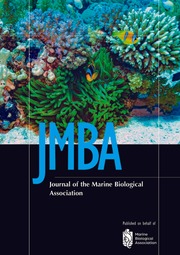Crossref Citations
This article has been cited by the following publications. This list is generated based on data provided by
Crossref.
Natsukari, Yutaka
Nakanose, Tatsuya
and
Oda, Kazunari
1988.
Age and growth of loliginid squid Photololigo edulis (Hoyle, 1885).
Journal of Experimental Marine Biology and Ecology,
Vol. 116,
Issue. 2,
p.
177.
Carvalho, G.R.
and
Pitcher, T.J.
1989.
Biochemical genetic studies on the Patagonian squid Loligo gahi d'Orbigny. II. Population structure in Falkland waters using isozymes, morphometrics and life history data.
Journal of Experimental Marine Biology and Ecology,
Vol. 126,
Issue. 3,
p.
243.
Rodhouse, P.G.
and
Hatfield, E.M.C.
1990.
Age determination in squid using statolith growth increments.
Fisheries Research,
Vol. 8,
Issue. 4,
p.
323.
Boyle, P.R.
1990.
Cephalopod biology in the fisheries context.
Fisheries Research,
Vol. 8,
Issue. 4,
p.
303.
Budelmann, Bernd U.
1990.
Squid as Experimental Animals.
p.
421.
Natsukari, Yutaka
and
Komine, Naoki
1992.
Age and growth estimation of the European squid, Loligo vulgaris, based on statolith microstructure.
Journal of the Marine Biological Association of the United Kingdom,
Vol. 72,
Issue. 2,
p.
271.
Villanueva, Roger
1992.
Interannual growth differences in the oceanic squid Todarodes angolensis Adam in the northern Benguela upwelling system, based on statolith growth increment analysis.
Journal of Experimental Marine Biology and Ecology,
Vol. 159,
Issue. 2,
p.
157.
Arkhipkin, Alexander
and
Mikheev, Alexander
1992.
Age and growth of the squid Sthenoteuthis pteropus (Oegopsida: Ommastrephidae) from the Central-East Atlantic.
Journal of Experimental Marine Biology and Ecology,
Vol. 163,
Issue. 2,
p.
261.
Pirker, J. G.
and
Schiel, D. R.
1993.
Tetracycline as a fluorescent shell-marker in the abalone Haliotis iris.
Marine Biology,
Vol. 116,
Issue. 1,
p.
81.
Arkhipkin, Alexander
and
Nekludova, Nataly
1993.
Age, growth and maturation of the loliginid squids Alloteuthis africana and A. Subulata on the west African shelf.
Journal of the Marine Biological Association of the United Kingdom,
Vol. 73,
Issue. 4,
p.
949.
Arkhipkin, Alexander
1993.
Statolith Microstructure and Maximum age of Loligo Gahi (Myopsida: Loliginidae) on the Patagonian Shelf.
Journal of the Marine Biological Association of the United Kingdom,
Vol. 73,
Issue. 4,
p.
979.
Guerra, Angel
and
Rocha, Francisco
1994.
The life history of Loligo vulgaris and Loligo forbesi (Cephalopoda: Loliginidae) in Galician waters (NW Spain).
Fisheries Research,
Vol. 21,
Issue. 1-2,
p.
43.
Jackson, George D.
1994.
Application and Future Potential of Statolith Increment Analysis in Squids and Sepioids.
Canadian Journal of Fisheries and Aquatic Sciences,
Vol. 51,
Issue. 11,
p.
2612.
Young, R. E.
and
Mangold, K. M.
1994.
Growth and reproduction in the mesopelagic-boundary squid Abralia trigonura.
Marine Biology,
Vol. 119,
Issue. 3,
p.
413.
Arkhipkin, Alexander I.
1995.
Statolith microstructure and maximum age of the sepiolidRossia pacifica(cephalopoda, sepioidea) in the Northern part of the North Pacific.
Sarsia,
Vol. 80,
Issue. 3,
p.
237.
Collins, M. A.
Burnell, G. M.
and
Rodhouse, P. G.
1995.
Age and growth of the squid Loligo forbesi (Cephalopoda: Loliginidae) in Irish waters.
Journal of the Marine Biological Association of the United Kingdom,
Vol. 75,
Issue. 3,
p.
605.
Arkhipkin, Alexander
1995.
Age, growth and maturation of the European squid Loligo vulgaris (Myopsida, Loliginidae) on the west Saharan shelf.
Journal of the Marine Biological Association of the United Kingdom,
Vol. 75,
Issue. 3,
p.
593.
Yatsu, Akihiko
Midorikawa, Satoshi
Shimada, Takahiro
and
Uozumi, Yuji
1997.
Age and growth of the neon flying squid, Ommastrephes bartrami, in the North Pacific ocean.
Fisheries Research,
Vol. 29,
Issue. 3,
p.
257.
Ikeda, Yuzuru
Arai, Nobuaki
Sakamoto, Wataru
Kodokoro, Hideaki
and
Yoshida, Koji
1998.
Microchemistry of the Statoliths of the Japanese Common Squid <i>Todarodes pacificus</i> with Special Reference to its Relation to the Vertical Temperature Profiles of Squid Habitat.
Fisheries science,
Vol. 64,
Issue. 2,
p.
179.
Lordan, C.
Collins, M.A.
and
Perales-Raya, C.
1998.
Observations on Morphology, Age and Diet of Three Architeuthis Caught Off the West Coast of Ireland in 1995.
Journal of the Marine Biological Association of the United Kingdom,
Vol. 78,
Issue. 3,
p.
903.

